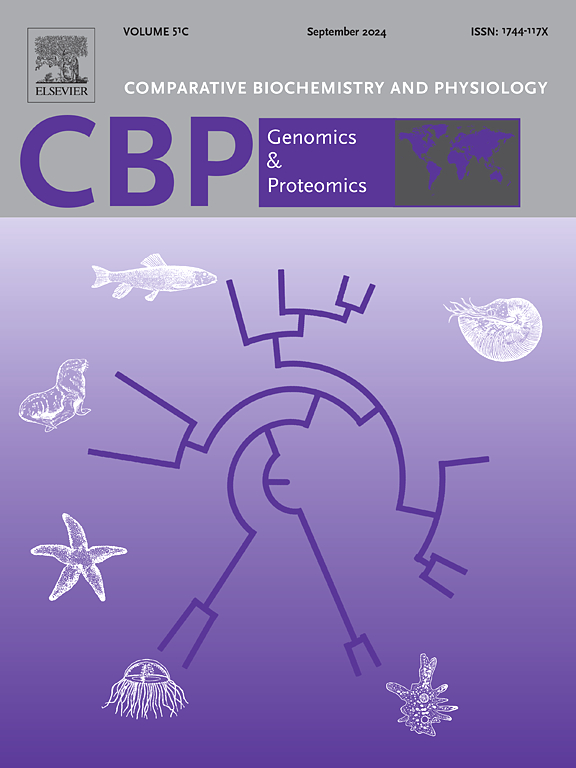Genome-wide identification and characterization of heat shock protein superfamily in the cotton aphid Aphis gossypii: phylogenetic, structural, and expression profiles analyses
IF 2.2
2区 生物学
Q4 BIOCHEMISTRY & MOLECULAR BIOLOGY
Comparative Biochemistry and Physiology D-Genomics & Proteomics
Pub Date : 2025-07-18
DOI:10.1016/j.cbd.2025.101583
引用次数: 0
Abstract
The cotton aphid, Aphis gossypii, belonging to Hemiptera Aphididae is a worldwide pest on various plants. This pest is particularly notorious for its high tolerance to both temperature and insecticides. Heat shock proteins (HSPs), which have been recognized as molecular chaperones, play pivotal roles in the response of insects to environmental stress. However, information on HSP genes in A. gossypii and their expression response remain limited. In this study, 50 HSP genes were identified in the A. gossypii genome, including 3 HSP90s, 15 HSP70s, 11 HSP60s, 19 HSP40s and 2 sHSPs. Phylogenetic analysis strongly supported the family classification of A. gossypii HSP genes. All of the AgHSPs were distributed across four chromosomes, and several gene duplication events were observed. Transcriptome data revealed that most AgHSPs could be induced by short-term high temperature treatment. Conversely, most HSPs decreased their transcription levels under long-term high temperature exposure. Notably, three HSPs (AgHSP40-9-X2, AgHSP40-15 and AgHSP70-8) were consistently up-regulated after insecticide exposure in both susceptible and resistant populations. Moreover, the expressions of HSPs across several morphs of aphids were systematically evaluated for the first time. Our findings provide fundamental data for future studies and enhance our understanding of the roles of HSPs in environmental stress adaptation in A. gossypii.

棉蚜热休克蛋白超家族的全基因组鉴定和表征:系统发育、结构和表达谱分析
棉蚜(Aphis gossypii)是半翅目棉蚜科的一种世界性害虫。这种害虫因其对温度和杀虫剂的高耐受性而臭名昭著。热休克蛋白作为一种分子伴侣蛋白,在昆虫对环境胁迫的反应中起着关键作用。然而,关于棉蚜HSP基因及其表达反应的信息仍然有限。本研究共鉴定出50个热休克蛋白基因,其中hsp90基因3个,hsp70基因15个,hsp60基因11个,hsp40基因19个,shsp基因2个。系统发育分析有力地支持了棉蚜HSP基因的家族分类。所有的AgHSPs分布在4条染色体上,并且观察到几个基因重复事件。转录组数据显示,大多数AgHSPs可以通过短期高温处理诱导。相反,在长期高温暴露下,大多数热休克蛋白的转录水平降低。值得注意的是,3种热休克蛋白(AgHSP40-9-X2、AgHSP40-15和AgHSP70-8)在杀虫剂暴露后在易感和抗性群体中一致上调。此外,我们还首次系统地评价了几种蚜虫形态中热休克蛋白的表达。本研究结果为今后的研究提供了基础数据,并加深了我们对热休克蛋白在棉蚜环境胁迫适应中的作用的认识。
本文章由计算机程序翻译,如有差异,请以英文原文为准。
求助全文
约1分钟内获得全文
求助全文
来源期刊
CiteScore
5.10
自引率
3.30%
发文量
69
审稿时长
33 days
期刊介绍:
Comparative Biochemistry & Physiology (CBP) publishes papers in comparative, environmental and evolutionary physiology.
Part D: Genomics and Proteomics (CBPD), focuses on “omics” approaches to physiology, including comparative and functional genomics, metagenomics, transcriptomics, proteomics, metabolomics, and lipidomics. Most studies employ “omics” and/or system biology to test specific hypotheses about molecular and biochemical mechanisms underlying physiological responses to the environment. We encourage papers that address fundamental questions in comparative physiology and biochemistry rather than studies with a focus that is purely technical, methodological or descriptive in nature.

 求助内容:
求助内容: 应助结果提醒方式:
应助结果提醒方式:


